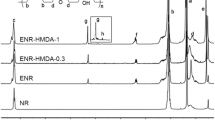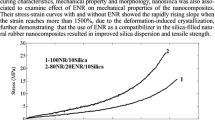Abstract
Reversible networks of epoxidized natural rubber (ENR) mixed with dicarboxylic acid were studied. ENR is a bio-based polymer, commercially available, and capable of sulphur vulcanisation. In addition, ENR has been already reported to exhibit self-healing characteristics after ionisation by adding ionic groups to the epoxide group. The reversible network structure plays an essential role for self-healing behaviour, which cannot be obtained for elastomers with irreversible sulphur network. In this study, dicarboxylic acid was used to construct the reversible network. The reversible hydrogen bonds were established in such a way that firstly one carboxyl group of di-carboxylic acid (DA) is reacted to ENR and secondary the other carboxyl group of DA interacts with residual carboxyl group to form hydrogen bonds in carboxylic dimer. The self-healing behaviour was evaluated for ENR with DA by tensile tests. This self-healing system provides new insights for sustainable and natural-based materials.








Similar content being viewed by others
References
Wright KRS, Botha TR, Els PS (2019) Effects of age and wear on the stiffness and friction properties of an SUV tyre. J Terramech 84:21–30
Euchler E, Heinrich G, Tada T, Ishikawa M (2018) The effect of boundary conditions on the failure behavior of rubber vulcanizates under tensile deformation. Kautschuk-Gummi-Kunststoff 9:32–38
Euchler E, Bernhardt R, Schneider K, Heinrich G, Wießner S, Tada T (2020) In situ dilatometry and X-ray microtomography study on the formation and growth of cavities in unfilled styrene-butadiene-rubber vulcanizates subjected to constrained tensile deformation. Polymer 187:122086
Euchler E, Bernhardt R, Schneider K, Heinrich G, Tada T, Wießner S, Stommel M (2020) Cavitation in rubber vukcanizates subjected to constrained tensile deformation. In: Heinrich G, Stocek R, Kipscholl R (eds) Advances in polymer science 286 (fatigue crack growth) in rubber materials. Springer, Berlin, pp 203–224
Euchler E, Bernhardt R, Wilde F, Schneider K, Heinrich G, Tada T, Wießner S, Stommel M (2021) First-time investigations on cavitation in rubber parts subjected to constrained tension using in situ synchrotron X-ray microtomography (SRμCT). Adv Eng Mater 23(11):2001347
Euchler E, Bernhardt R, Schneider K, Tada T, Wießner S (2021) Experimental study on cavitation in rubber vulcanizates subjected to constrained tensile deformation. Proc Appl Math Mech 21(1):e202100023
Blaiszik BJ, Kramer SLB, Olugebefola SC, Moore JS, Sottos NR, White SR (2010) Self-healing polymers and composites. Ann Rev Mater Res 40:179–211
Murphy EB, Bolanos E, Schaffner-Hamann C, Wudl F, Nutt SR, Auad ML (2008) Synthesis and characterization of a single-component thermally remendable polymer network: staudinger and stille revisited. Macromolecules 41:5203–5209
Deng G, Tang C, Li F, Jiang H, Chen Y (2010) Covalent cross-linked polymer gels with reversible sol−gel transition and self-healing properties. Macromolecules 43:1191–1194
Fu F, Huang M, Zhang W, Zhao Y, Liu X (2018) Thermally assisted self-healing behavior of anhydride modified polybenzoxazines based on transesterification. Sci Rep 8:10325
Das A, Sallat A, Böhme F, Suckow M, Basu D, Wießner S, Stöckelhuber KW, Voit B, Heinrich G (2015) Interfaces ionic modification turns commercial rubber into a self-healing material. ACS Appl Mater. 7:20623–20630
Le HH, Böhme F, Sallat A, Wießner S, Landwehr M, Reuter U, Stöckelhuber KW, Heinrich G, Radusch HJ, Das A (2017) Temperature scanning stress relaxation of an autonomous self-healing elastomer containing non-covalent reversible network junctions. Macromol Mater Eng 302:1600385
Le HH, Hait S, Das A, Wiessner S, Stoeckelhuber K, Böhme F, Reuter U, Naskar K, Heinrich G, Radusch H (2017) Self-healing properties of carbon nanotube filled natural rubber/bromobutyl rubber blends. Express Polym Lett 11:230
Sallat A, Das A, Schaber J, Scheler U, Bhagavatheswaran ES, Stöckelhuber KW, Heinrich G, Voit B, Böhme F (2018) Viscoelastic and self-healing behavior of silica filled ionically modified poly(isobutylene-co-isoprene) rubber. RSC Adv 8:26793–26803
Xu C, Huang X, Li C, Chen Y, Lin B, Liang X (2016) Design of “Zn2+ Salt-Bondings” cross-linked carboxylated styrene butadiene rubber with reprocessing and recycling ability via rearrangements of ionic cross-linkings. ACS Sustain Chem Eng 4:6981–6990
Wang Q, Wang W, Li Q, Wu C (2021) Mechanically robust and recyclable styrene-butadiene rubber cross-linked via Cu2+–nitrogen coordination bond after a tetrazine click reaction. Ind Eng Chem Res 60:2163–2177
Sarkar S, Banerjee SL, Singha NK (2021) Self-healable hydrophobic material based on anthracenyl functionalized fluorous block copolymers via reversible addition-fragmentation chain transfer polymerization and rapid diels-alder reaction. Macromol Mater Eng 306:2000626
Wang Q, Shi Y, Li Q, Wu C (2021) Toughening, recyclable and healable nitrile rubber based on multi-coordination crosslink networks after “tetrazine click” reaction. Eur Polym J 150:110415
Miwa Y, Kurachi J, Sugino Y, Udagawa T, Kutsumizu S (2020) Toward strong self-healing polyisoprene elastomers with dynamic ionic crosslinks. Soft Matter 16:3384–3394
Xu C, Nie J, Wu W, Zheng Z, Chen Y (2019) Self-healable, recyclable, and strengthened epoxidized natural rubber/carboxymethyl chitosan biobased composites with hydrogen bonding supramolecular hybrid networks. ACS Sustain Chem Eng 7:15778–15789
Zhang X, Tang Z, Guo B, Zhang L (2016) Enabling design of advanced elastomer with bioinspired metal-oxygen coordination. ACS Appl Mater Interfaces 8:32520–32527
Imbernon L, Oikonomou EK, Norvez S, Leiblera L (2015) Chemically crosslinked yet reprocessable epoxidized natural rubber via thermo-activated disulfide rearrangements. Polym Chem 6:4271–4278
Feng Z, Hu J, Zuo H, Ning N, Zhang L, Yu B, Tian M (2018) Photothermal-induced self-healable and reconfigurable shape memory bio-based elastomer with recyclable ability. ACS Appl Mater Interfaces 11:1469–1479
Cheng B, Lu X, Zhou J, Qin R, Yang Y (2019) Dual cross-linked self-healing and recyclable epoxidized natural rubber based on multiple reversible effects. ACS Sustain Chem Eng 7:4443–4455
Utrera-Barrios S, Santana MH, Verdejo R, López-Manchado MA (2020) Design of rubber composites with autonomous self-healing capability. ACS Omega 5:1902–1910
Cao L, Gong Z, Liu C, Fan J, Chen Y (2021) Design and fabrication of mechanically strong and self-healing rubbers via metal-ligand coordination bonds as dynamic crosslinks. Compos Sci Technol 207:108750
Algaily B, Kaewsakul W, Sarkawi SS, Kalkornsurapranee E (2021) Alleviating molecular-scale damages in silica-reinforced natural rubber compounds by a self-healing modifier. Polymers 13:39
Algaily B, Kaewsakul W, Sarkawi SS, Kalkornsurapranee E (2021) A self-healing system based on ester crosslinks for carbon black-filled rubber compounds. J Compos Sci 5:70
Mandal S, Simon F, Banerjee SS, Tunnicliffe LB, Nakason C, Das C, Das M, Naskar K, Wiessner S, Heinrich G, Das A (2021) Controlled release of metal ion cross-linkers and development of self-healable epoxidized natural rubber. ACS Appl Polym Mater 3:1190–1202
Gong Z, Huang J, Cao L, Xu C, Chen Y (2022) Self-healing epoxidized natural rubber with ionic/coordination crosslinks. Mater Chem Phys 285:126063
Liu W, Huang J, Gong Z, Fan J, Chen YH (2022) Healable, recyclable and mechanically robust elastomers with multiple dynamic cross-linking bonds. Polymer 252:124900
Mandal S, Hait S, Simon F, Ghosh A, Scheler U, Arief I, Tada T, Hoang YX, Wießner S, Heinrich G, Das A (2022) Transformation of epoxidized natural rubber into ionomers by grafting of 1himidazolium ion and development of a dynamic reversible network. ASC Appl Polym Mater 4:6612–6622
Pire M, Norvez S, Iliopoulos I, Le Rossignol B, Leibler L (2010) Epoxidized natural rubber/dicarboxylic acid self-vulcanized blends. Polymer 51:5903–5909
Pire M, Norvez S, Iliopoulos I, Le Rossignol B, Leibler L (2014) Dicarboxylic acids may compete with standard vulcanisation processes for crosslinking epoxidised natural rubber. Compos Interfaces 21:45–50
Author information
Authors and Affiliations
Corresponding author
Ethics declarations
Conflict of interest
The authors declare no conflicts of interest associated with this manuscript.
Additional information
Publisher's Note
Springer Nature remains neutral with regard to jurisdictional claims in published maps and institutional affiliations.
Rights and permissions
Springer Nature or its licensor (e.g. a society or other partner) holds exclusive rights to this article under a publishing agreement with the author(s) or other rightsholder(s); author self-archiving of the accepted manuscript version of this article is solely governed by the terms of such publishing agreement and applicable law.
About this article
Cite this article
Sawada, J., Mandal, S., Das, A. et al. Hydrogen bonding network formation in epoxidized natural rubber. Polym. Bull. 81, 5991–6002 (2024). https://doi.org/10.1007/s00289-023-04968-2
Received:
Revised:
Accepted:
Published:
Issue Date:
DOI: https://doi.org/10.1007/s00289-023-04968-2




